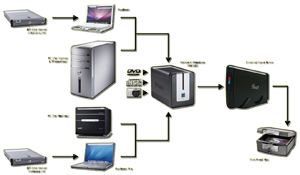Networking Issues - Computer Repair, Networking, Website, On-site Tech, Printer, mynians.com
Main menu
- Home Page
- Computer
- Networking
- Recovery
- Services
- Design
-
Contact
- Contact
- About Us
- Resources
- Pay On-Line
Networking Issues
Domain : A group of computers and devices on a network that are administered as a unit with common rules and procedures. Within the Internet, domains are defined by the IP address. All devices sharing a common part of the IP address are said to be in the same domain.
(2) In database technology, domain refers to the description of an attribute's allowed values. The physical description is a set of values the attribute can have, and the semantic, or logical, description is the meaning of the attribute.

Router : A device that forwards data packets along networks. A router is connected to at least two networks, commonly two LANs or WANs or a LAN and its ISP’s network. Routers are located at gateways, the places where two or more networks connect.
Routers use headers and forwarding tables to determine the best path for forwarding the packets, and they use protocols such as ICMP to communicate with each other and configure the best route between any two hosts.
Very little filtering of data is done through routers.
IIS : Short for Internet Information Server, Microsoft's Web server that runs on Windows NT platforms.In fact, IIS comes bundled with Windows NT 4.0. Because IIS is tightly integrated with the operating system, it is relatively easy to administer. However, currently IIS is available only for the Windows NT platform, whereas Netscape's Web servers run on all major platforms, including Windows NT, OS/2 and UNIX.
R.A.I.D. : Short for Redundant Array of Independent (or Inexpensive) Disks, a category of disk drives that employ two or more drives in combination for fault tolerance and performance.RAID disk drives are used frequently on servers but aren't generally necessary for personal computers.
There are number of different RAID levels:
Level 0 -
Level 1
Level 2
Level 3
Level 4
Level 5
Level 6
Level 7
RAID S: EMC Corporation's proprietary striped parity RAID system used in its Symmetrix storage systems.
Level 0+1
Level 10